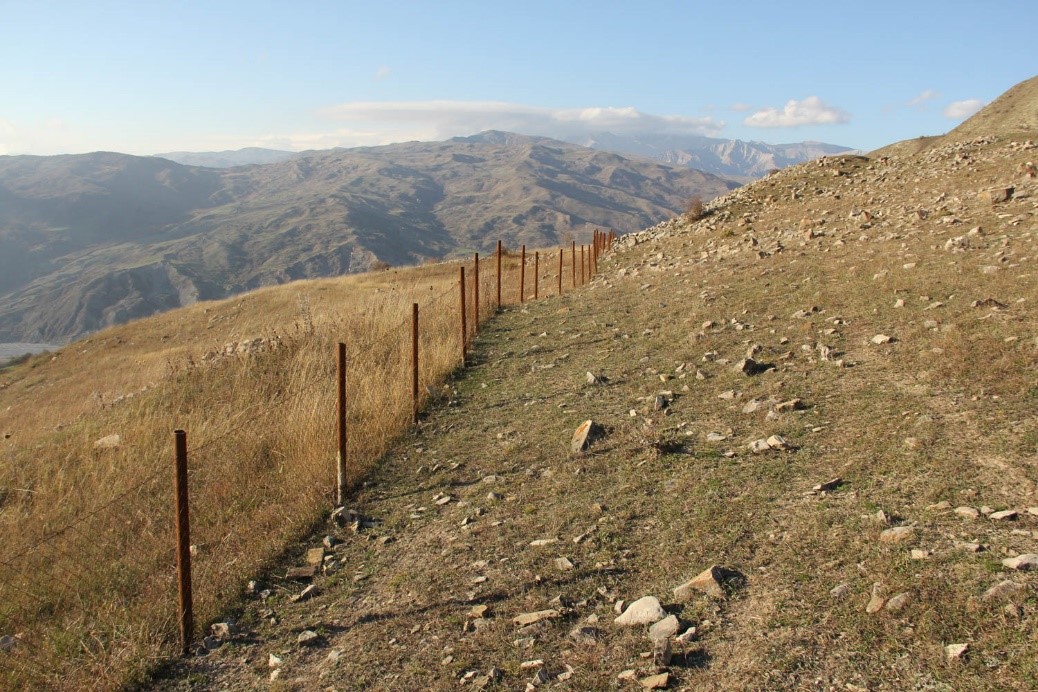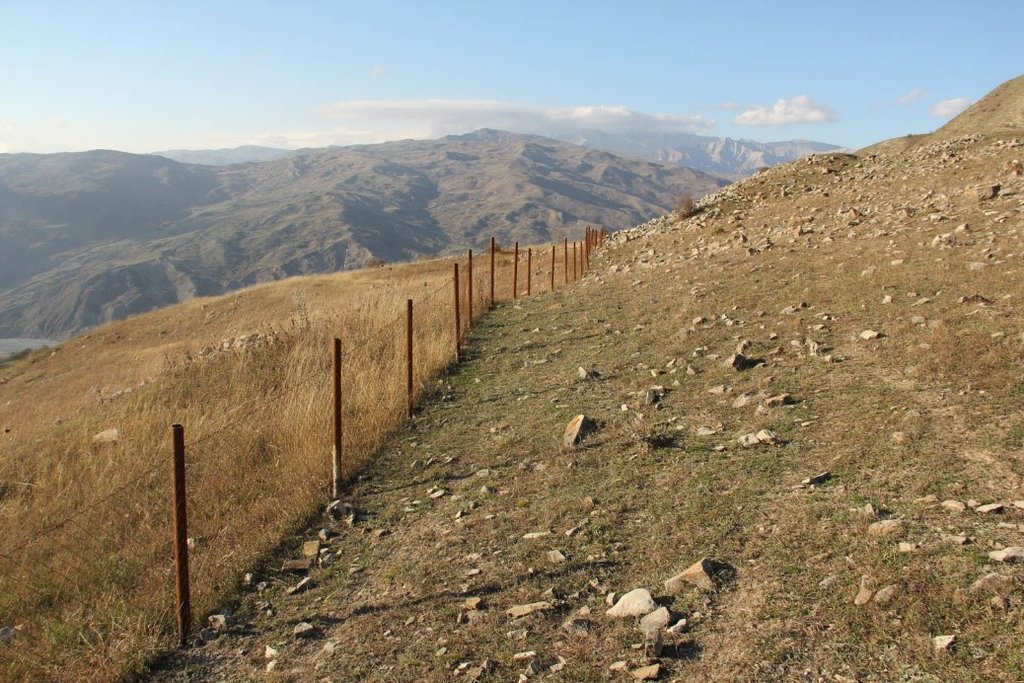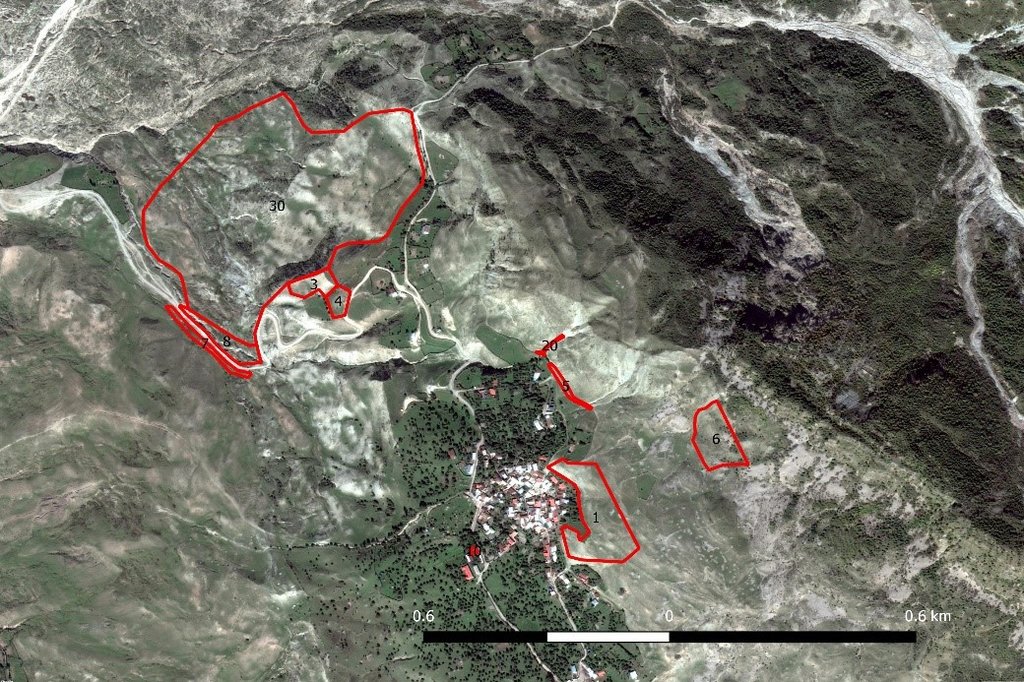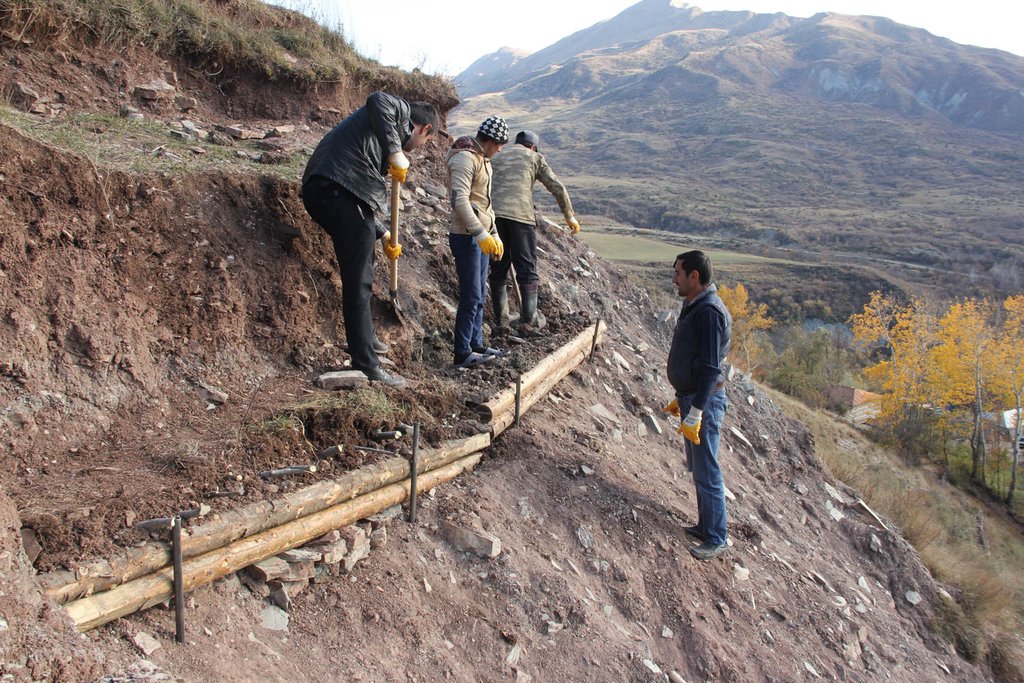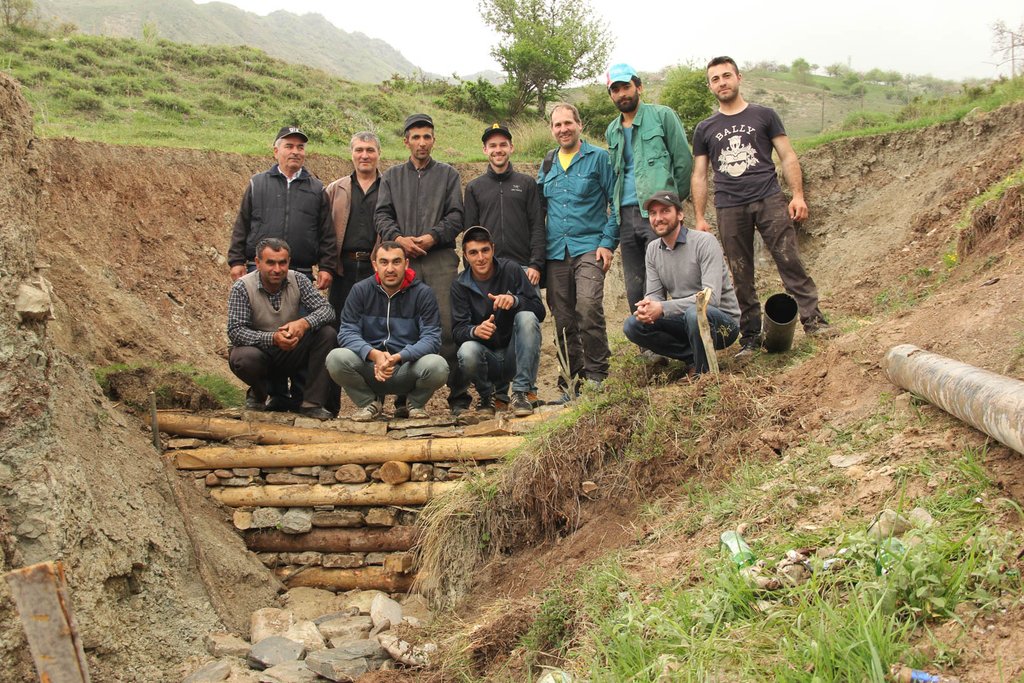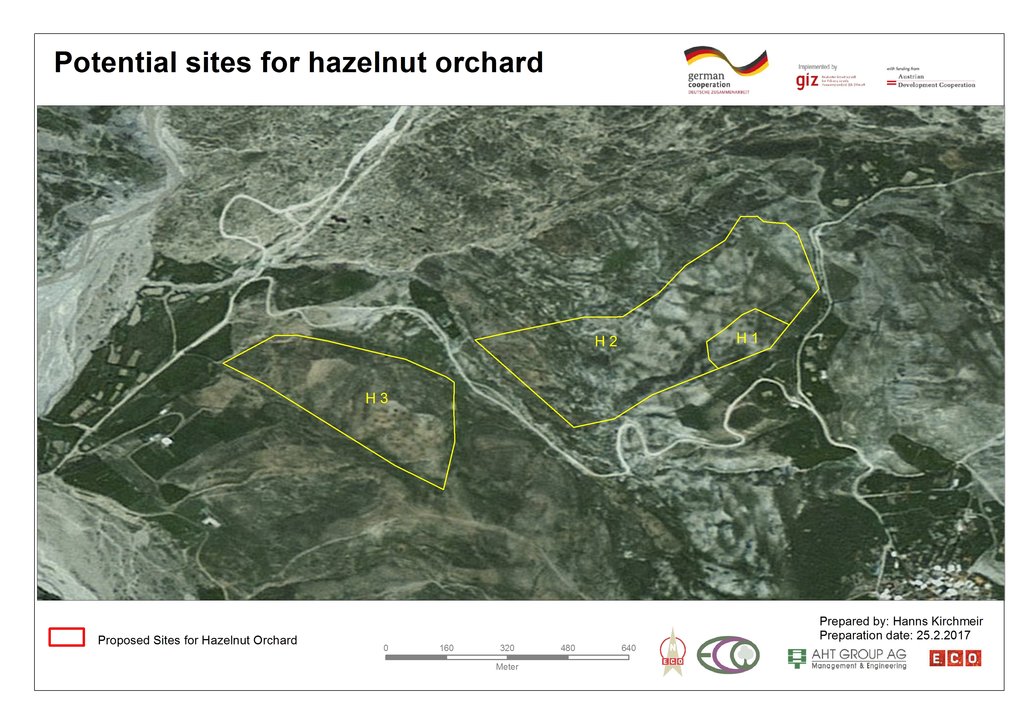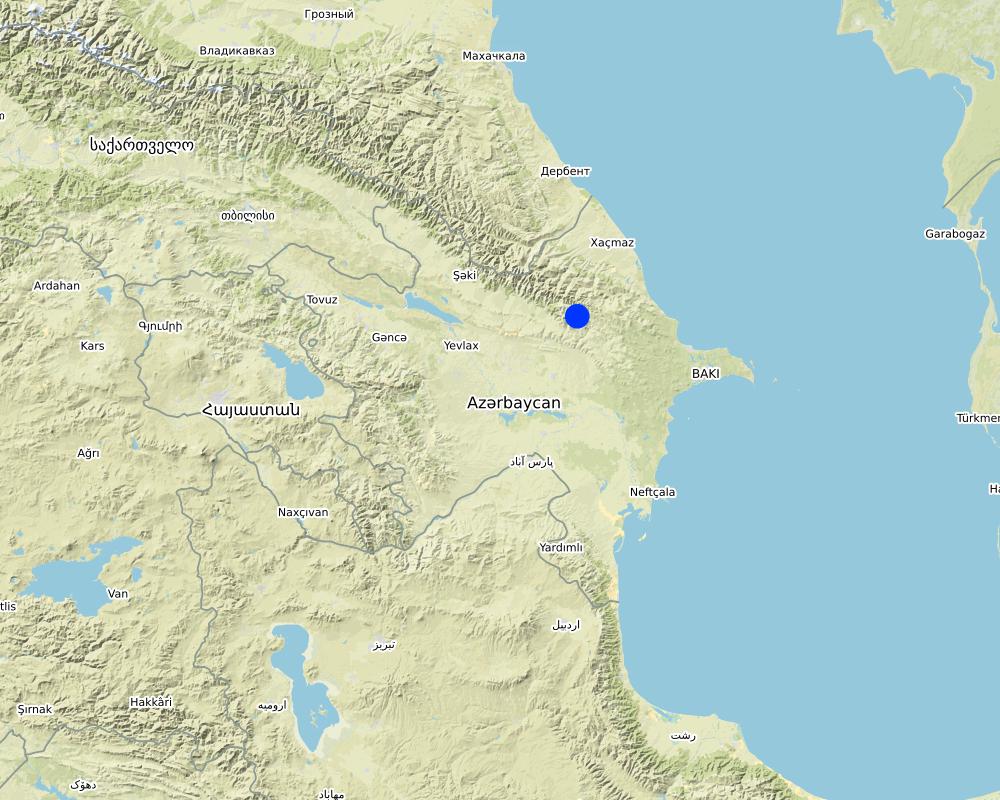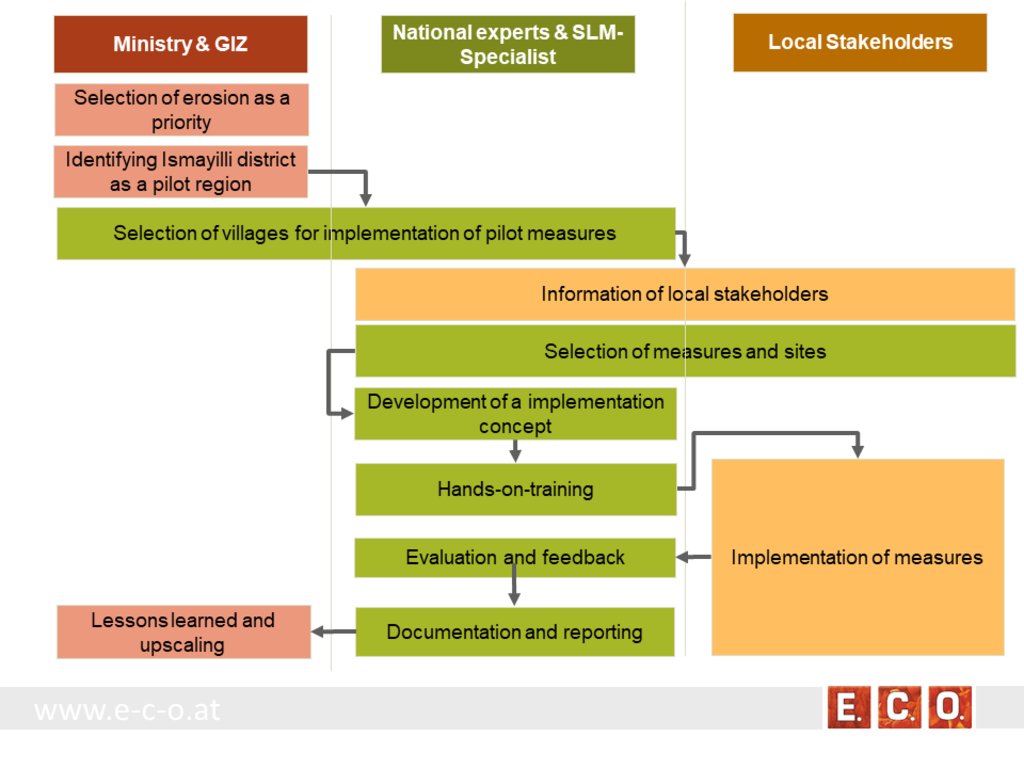Community-based approach in Erosion Control [ອາເຊີໄບຈານ]
- ການສ້າງ:
- ປັບປູງ:
- ຜູ້ສັງລວມຂໍ້ມູນ: Hanns Kirchmeir
- ບັນນາທິການ: Markus Koeppler, Samir Abbasov
- ຜູ້ທົບທວນຄືນ: Rima Mekdaschi Studer
Ismayilly district, Ehen community
approaches_5571 - ອາເຊີໄບຈານ
ເບິ່ງພາກສ່ວນ
ຂະຫຍາຍທັງໝົດ ຍຸບທັງໝົດ1. ຂໍ້ມູນທົ່ວໄປ
1.2 ລາຍລະອຽດ ການຕິດຕໍ່ ຂອງບຸກຄົນທີ່ຊັບພະຍາກອນ ແລະ ສະຖາບັນ ການມີສ່ວນຮ່ວມ ໃນການປະເມີນຜົນ ແລະ ເອກະສານ ຂອງວິທີທາງ
ຜູ້ຊ່ຽວຊານ ດ້ານການຄຸ້ມຄອງ ທີ່ດິນແບບຍືນຍົງ:
ຊື່ຂອງໂຄງການ ທີ່ອໍານວຍຄວາມສະດວກ ໃນການສ້າງເອກກະສານ ຫຼື ປະເມີນດ້ານແນວທາງ (ຖ້າກ່ຽວຂ້ອງ)
Integrated Biodiversity Management, South Caucasus (IBiS)ຊື່ຂອງ ສະຖາບັນການຈັດຕັ້ງ ທີ່ອໍານວຍຄວາມສະດວກ ໃນການສ້າງເອກກະສານ ຫຼື ປະເມີນແນວທາງ (ຖ້າກ່ຽວຂ້ອງ)
Deutsche Gesellschaft für Internationale Zusammenarbeit (GIZ)1.3 ເງື່ອນໄຂ ຂອງການນໍາໃຊ້ເອກກະສານຂໍ້ມູນ ຂອງ WOCAT
ເມື່ອໃດທີ່ໄດ້ສັງລວມຂໍ້ມູນ (ຢູ່ພາກສະໜາມ)?
31/10/2018
ຜູ້ສັງລວມ ແລະ ບັນດາຜູ້ຕອບແບບສອບຖາມ ຍອມຮັບໃນເງື່ອນໄຂ ການນໍາໃຊ້ຂໍ້ມູນເອກະສານ ທີ່ສ້າງຂື້ນ ໂດຍຜ່ານ ອົງການ WOCAT:
ແມ່ນ
1.4 ເອກະສານອ້າງອີງ (ຫຼາຍ) ກັບແບບສອບຖາມ (ຫຼາຍ) ເຕັກໂນໂລຢີ ຂອງດ້ານການຄຸ້ມຄອງ ດິນແບບຍືນຍົງ
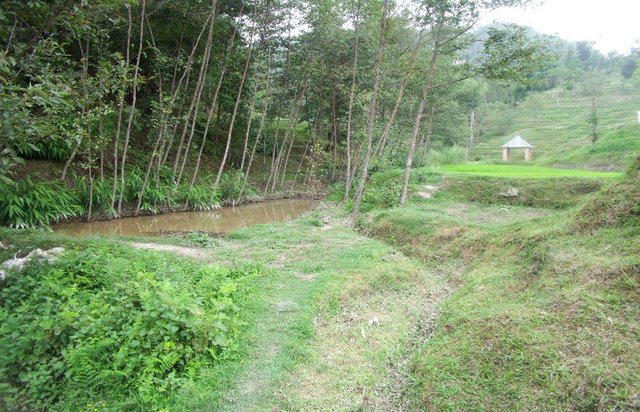
Sustainable land management using controlled gullying [ເນໂປ]
An indigenous technology to help control channelled water during the rainy season and conserve it during the dry season
- ຜູ້ສັງລວມຂໍ້ມູນ: Shreedip Sigdel
2. ພັນລະນາ ແນວທາງການຄຸ້ມຄອງນໍາໃຊ້ດິນແບບຍືນຍົງ
2.1 ການອະທິບາຍ ໂດຍຫຍໍ້ ຂອງວິທີທາງ
The unsustainable use of pastures and forest areas leads to erosion, degradation, desertification and loss of biodiversity in high mountain areas of the South Caucasus. In the village Ehen in the Ismayilli district in Azerbaijan, a community-based approach for erosion control was developed in a participative way. Together with village stakeholders, different measures were developed to stop erosive processes, flooding and to rehabilitate vegetation cover.
2.2 ການອະທິບາຍ ລາຍລະອຽດ ຂອງວິທີທາງ
ການອະທິບາຍ ລາຍລະອຽດ ຂອງວິທີທາງ:
The Ministry of Ecology and Natural Resources of Azerbaijan togehter witht the Deutsche Gesellschaft fuer Zusammenarbeit (GIZ) selected integrated erosion control as a priority in their cooperation and the district Ismayilli was choosen for the implementation of pilot activities.
The district Ismayilli covers an area of about 2.158 km². Approximately 31% of the territory is covered with forest. Pasture lands on slopes are particularly exposed to vegetation degradation due to overgrazing. The loss of a closed vegetation cover on mountain slopes can lead to severe soil erosion due to surface water runoff. The project team together with the district administration decided to set the focus on the village Ehen near Lahic.
The approach chosen for integrated erosion control in Ehen was a community-based approach. Together with stakeholders, the most severe erosion sites were identified, and a list of priorities was developed. In cooperation with international experts, different technologies and practices were developed to stop erosion processes. Several preconditions for the development of a number of practices were set: The technologies should be cost-effective and affordable for the villagers, and the villagers should be able to use them without the use of external technicians. In order to achieve this, particular emphasis was placed on the application of bio-engineering measures. Measures were applied on degraded pasture lands and erosion gullies in the pilot community at the south slope of the Great Caucasus.
As a first step, the implementation sites were determined through joint field visits by village representatives and experts ('Screening mission'). In the first face the GIZ-team and the SLM-experts have been introduced to the village community. In this phase, the national GIZ project coordinator had the major role to create a basis of respect and trust to enable a positive athomisphere for an open minded discussion. The driving factors of deforestation and overgrazing were discussed in the field, and the potential intervention sites were marked with colour spray and wooden poles in the field. The marking in the field instead of only working with printed maps was very important for the recognition, discussion and acceptance of the sites by all villagers. There was a gap of several weeks between marking and implementation, which provided enough time for internal discussion about the site selection and the adaptation of boundaries.
Nine degraded pastures and forest land sites were selected by the village stakeholders togehter witht the SLM specialists. Four sites are located above the village with the risk of increasing rockfall and flooding by surface water runoff. Five sites are located below the village and were selected to ensure the productivity of the land. For providing tree seedlings, a local tree nursery was established near the school (10th site). One site was selected to combine effects by establishing a hazelnut plantation to stop erosion, increase vegetation cover and provide an income generation opportunity.
Two sites with gully erosion were selected: a site above the village with the risk of flooding into the village and a site below the village along the road with a high risk of road damage if the deepening process continues (detailed instructions on measures can be found at the internet links attached).
Regular meetings took place between the traditional administrative community board, the GIZ-project team and the SLM experts to discuss the implementation process and to evaluate together the results. The availability of local resources was taken into consideration to adapt technologies to fit the local needs. New ideas, localy available materials and technologies have beein integrated into the implementation process by the local stakeholders.
The implementation of the measures was done mainly by the local village people and local experts. The SLM experts provided 'hands-on-training' and all materials that were not available in the village as well external experts were financed by the project.
Another essential aspect is the sustainable use of well-managed meadows by different stakeholders (beekeepers, wild herb collectors, orchard owners and others) in the community. This includes the agreement (rule) of the community to share the protected pastures and to consider the needs of all interest groups. The decission of the profit sharing is taken by the taditional administrative community board. A further factor was the establishment of a tree nursery, which led to an increased motivation to plant additional trees (especially fruit trees) in the community.
2.3 ຮູບພາບຂອງແນວທາງ
2.4 ວີດີໂອ ຂອງວິທີທາງ
2.5 ປະເທດ / ເຂດ / ສະຖານທີ່ບ່ອນທີ່ແນວທາງໄດ້ຖືກນໍາໃຊ້
ປະເທດ:
ອາເຊີໄບຈານ
ພາກພື້ນ / ລັດ / ແຂວງ:
Ehen village
ຂໍ້ມູນເພີ່ມເຕີມຂອງສະຖານທີ່:
DIistrict Ismayilli
ຄວາມຄິດເຫັນ:
The pilot sites belong to Ehen village within the district Ismayilli.
Map
×2.6 ວັນທີເລີ່ມຕົ້ນ ແລະ ສິ້ນສຸດ ການຈັດຕັ້ງປະຕີບັດ ວິທີທາງ
ສະແດງປີຂອງການເລີ່ມຕົ້ນ:
2015
ຖ້າຫາກບໍ່ຮູ້ຈັກປີທີ່ແນ່ນອນ, ໃຫ້ປະມານຄາດຄະເນ ເອົາມື້ທີ່ໄດ້ເລີ່ມຈັດຕັ້ງປະຕິບັດ ວິທີທາງ:
ຕໍ່າກວ່າ 10 ປີ ຜ່ານມາ (ມາເຖິງປະຈຸບັນ)
ປີທີ່ສີ້ນສູດ (ຖ້າຢຸດບໍ່ໄດ້ນໍາໃຊ້ ວິທີທາງ):
2018
ຄວາມຄິດເຫັນ:
At the 10 locations of the village Ehen the implementation of the approach took place in the years 2016-2018.
2.7 ປະເພດຂອງແນວທາງ
- ພາຍໃຕ້ໂຄງການ / ແຜນງານ
2.8 ເປົ້າໝາຍ / ຈຸດປະສົງຫຼັກ ຂອງການຈັດຕັ້ງປະຕິບັດ ວິທີທາງ
Develop erosion control measures that can be implemented by village population without significant investment. The measures are addressed to rehabilitate vegetation on eroded sites and to slow down water speed and erosive energy where gullies already exist. This should help protect roads and other infrastructure as well as stop soil loss and increase overall productivity.
2.9 ເງື່ອນໄຂອໍານວຍ ຫຼື ຂັດຂວາງການປະຕິບັດຂອງເຕັກໂນໂລຢີ / ເຕັກໂນໂລຢີການນໍາໃຊ້ຕາມແນວທາງ
ສັງຄົມ / ວັດທະນະທໍາ / ມາດຕະຖານ ແລະ ຄຸນຄ່າທາງສາສະໜາ
- ອໍານວຍ
Local population tend to save resources such as forest and pasture surrounding their village. Residents, especially women collect wild plants to use in daily life. Furthermore, selling collected wild plants in the market, residents earn income.
ມີຄວາມສາມາດ / ເຂັ້າເຖິງຊັບພະຍາກອນດ້ານການເງິນ ແລະ ການບໍລິການ
- ອໍານວຍ
Most of the activities (fencing, willow fascines, pilewalls, gabion or wooden check dams) only need small-scale financial investments. Only the drip irrigation system for the hazelnut orchard needed significant external investment, and the return of the investment cannot be expected before 10 years. Such an investment would have been impossible for the village community without external support.
ການກໍ່ຕັ້ງສະຖາບັນ
- ອໍານວຍ
The Community Management Group was established at the early stage of the project.
ການຮ່ວມມື / ການປະສານງານຂອງຜູ້ກ່ຽວຂ້ອງ
- ອໍານວຍ
Pilot activities are implemented in cooperation with local decision makers and communities. The active involvement of the village people in the implementation works was a hands-on training.
ກ່ຽວກັບກົດໝາຍ (ສິດນໍາໃຊ້ດິນ, ສິດນໍາໃຊ້ນໍ້າ)
- ເຊື່ອງຊ້ອນ
The forest’s legal protection does not allow timber or poles to be taken from the forest for the construction of pile walls or wooden check dams. The poles had to be imported and transferred to the village. A balanced sustainable forest management would enable village people to make use of the local timber and would encourage people to establish forest areas.
ນະໂຍບາຍ
- ອໍານວຍ
The Azerbaijan policy to establish more than 2000ha of hazelnut orchard in the district of Ismayilli supports the decision to establish hazelnut orchards on eroded sites as a control measure.
ການປົກຄອງທີ່ດິນ (ການຕັດສິນໃຈ, ການປະຕິບັດ ແລະ ຂໍ້ບັງຄັບ)
- ອໍານວຍ
Pilot sites are located in municipality land. Community members and local authority decided the border of pilot sites.
ຄວາມຮູ້ກ່ຽວກັບການຄຸ້ມຄອງ ທີ່ດິນແບບຍືນຍົງ, ການເຂົ້າເຖິງການສະໜັບສະໜູນ ທາງດ້ານວິຊາການ
- ອໍານວຍ
Residents have some initial knowledge of sustainable land management. Implementing pilot activities their information is developed.
ຕະຫຼາດ (ໃນການຊື້ວັດຖຸດິບ, ຂາຍຜະລິດຕະພັນ) ແລະ ລາຄາ
- ອໍານວຍ
Collected wild plants are sold in the market located next to Ehen village.
ວຽກ, ມີກໍາລັງຄົນ
- ອໍານວຍ
The manpower is available in the village
3. ການມີສ່ວນຮ່ວມ ແລະ ບົດບາດຂອງພາກສ່ວນທີ່ກ່ຽວຂ້ອງທີ່ໄດ້ມີສ່ວນຮ່ວມ
3.1 ຜູ້ມີສ່ວນຮ່ວມ ໃນວິທີທາງ ແລະ ພາລະບົດບາດ ຂອງເຂົາເຈົ້າ
- ຜູ້ນໍາໃຊ້ດິນໃນທ້ອງຖິ່ນ / ຊຸມຊົນທ້ອງຖິ່ນ
Livestock farmers, shepherds, smallholder farms and women that were loosely organised.
Selection of sites for intervention, providing labour during implementation of measure, local hay residuals provided by farmers for testing the measure, maintenance of drip irrigation and electric fence of the hazelnut orchards.
- ຜູ້ຊ່ຽວຊານ ການນຄຸ້ມຄອງ ທີ່ດິນແບບຍືນຍົງ / ທີ່ປຶກສາດ້ານກະສິກໍາ
International and national specialists have been integrated.
The SLM specialist elaborated in close cooperation with the local stakeholders the implementation concept.
- ນັກຄົ້ນຄວ້າ
Researcher from the Agrarian University in Ganja.
- ອໍານາດ ການປົກຄອງທ້ອງຖິ່ນ
Ministry of Ecology and Natural Resources, Ismayilli District Administration
Numerous pilot activities (test and demonstrate the most appropriate actions and raise awareness of the community on the long-term socio- economic and environmental benefits of the pilot actions) have been implemented In cooperation with local government in Ehen municipality.
3.2 ການມີສ່ວນຮ່ວມຂອງຜູ້ນໍາໃຊ້ທີ່ດິນໃນທ້ອງຖິ່ນ / ຊຸມຊົນທ້ອງຖິ່ນໃນໄລຍະທີ່ແຕກຕ່າງກັນຂອງແນວທາງ
| ການລວບລວມ ເອົາຜູ້ນໍາໃຊ້ດິນ ໃນທ້ອງຖິ່ນ / ຊຸມຊົນທ້ອງຖິ່ນ | ໃຫ້ລະບຸ ຜູ້ໃດທີ່ມີສ່ວນຮ່ວມ ໃນແຕ່ລະກິດຈະກໍາ? | |
|---|---|---|
| ການເລີ່ມຕົ້ນ / ແຮງຈູງໃຈ | ບໍ່ມີ | The selection of Ismayilli district was done at Ministry level. The selection of the villages was done with district administration and experts assessment of erosion problems. |
| ການວາງແຜນ | ການຮ່ວມມື | The site selection was done with local village stakeholders. The technical planning was done by external experts. Four additional municipalities were assessed for hazelnut plantations where local land users provided data. |
| ການປະຕິບັດ | ການຮ່ວມມື | Local stakeholders trained on bioengineering measures. The following measures were applied during hands-on training: 1. Wooden check-dam. 2. Gabion check-dam. 3. Willow-fascines. 4. Electric-Fencing. 5.Pile walls. 6.Drip irrigation system. |
| ຕິດຕາມກວດກາ / ການປະເມີນຜົນ | ການຮ່ວມມື | An external monitoring team (project team) did the monitoring in a participative way. The observations and monitoring results were discussed with the village stakeholders. |
3.3 ແຜນວາດ (ຖ້າມີ)
ການອະທິບາຍ:
This flow chart gives an overview on the different roles of project participants (Ministry and GIZ, the national experts and SLM specialists as well as the local stakeholders) and the actions implementented by them jointly or seperately.
3.4 ການຕັດສິນໃຈກ່ຽວກັບການຄັດເລືອກເຕັກໂນໂລຢີຂອງການຄຸ້ມຄອງທີ່ດິນແບບຍືນຍົງ / ເຕັກໂນໂລຢີ
ລະບຸ ຄົນທີ່ຕັດສິນໃຈ ກ່ຽວກັບການຄັດເລືອກຂອງ ເຕັກໂນໂລຢີ / ເຕັກໂນໂລຢີ ຈະໄດ້ຮັບການປະຕິບັດ:
- ຜູ້ຊ່ຽວຊານ ຫຼັກດ້ານການຄຸ້ມຄອງ ທີ່ດິນແບບຍືນຍົງ, ມີການຕິດຕາມປຶກສາຫາລືກັບຜູ້ນໍາໃຊ້ທີ່ດິນ
ອະທິບາຍ:
The integrated erosion control measures were developed by SLM specialists, while site selection and prioritization were done in conjunction with village community representatives.
Specify on what basis decisions were made:
- ຜົນທີ່ໄດ້ຮັບ ຈາກການຄົ້ນຄວ້າ
- ປະສົບການສ່ວນບຸກຄົນ ແລະ ຄວາມຄິດເຫັນ (ທີ່ບໍ່ເປັນເອກກະສານ)
4. ການສະໜັບສະໜູນທາງດ້ານວິຊາການ, ການສ້າງຄວາມສາມາດ, ແລະ ການຈັດການຄວາມຮູ້.
4.1 ການສ້າງຄວາມສາມາດ / ການຝຶກອົບຮົມ
ຜູ້ນໍາໃຊ້ທີ່ດິນ ຫຼື ພາກສ່ວນກ່ຽວຂ້ອງອື່ນໆ ໄດ້ຮັບການຝຶກອົບຮົມບໍ່?
ແມ່ນ
ໃຫ້ລະບຸ ຜູ້ໃດທີ່ໄດ້ຮັບການຝຶກອົບຮົມ:
- ຜູ້ນໍາໃຊ້ດິນ
- ພະນັກງານພາກສະໜາມ / ທີ່ປຶກສາ
ຖ້າເປັນໄປໄດ້, ໃຫ້ລະບຸເພດ, ອາຍຸ, ສະຖານະພາບ, ຊົນເຜົ່າ, ແລະ ອື່ນໆ:
Only men have been involved in the training of the application of the erosion control measures.
ຮູບແບບຂອງການຝຶກອົບຮົມ:
- ການເຮັດຕົວຈິງ
- ເນື້ອທີ່ສວນທົດລອງ
ໃນຫົວຂໍ້:
Construction of willow fascines, pill walls, wooden check dams, gabion check dams, tree planting, fence construction (electric fence, mesh wire fence), construction and maintenance of drip irrigation system.
ຄວາມຄິດເຫັນ:
In addition to the on-the-job training, an Austrian study tour was provided for Georgian participants. The focus of the joint study tour was to enable a direct experience of current practices in the Alps giving the participants an impression how the issue of land management and erosion control is handled in mountainous areas of Austria.
4.2 ການບໍລິການໃຫ້ຄໍາປຶກສາ
ເຮັດຜູ້ໃຊ້ທີ່ດິນມີການເຂົ້າເຖິງການບໍລິການໃຫ້ຄໍາປຶກສາ?
ແມ່ນ
ລະບຸວ່າການສະໜອງ ການບໍລິການ ໃຫ້ຄໍາປຶກສາ:
- ໃນພື້ນທີ່ຂອງຜູ້ນໍາໃຊ້ດິນ
ອະທິບາຍ / ຄວາມຄິດເຫັນ:
The field trip provided advice and training on afforestation and tree species selection.
4.3 ສະຖາບັນການສ້າງຄວາມເຂັ້ມແຂງ (ການພັດທະນາອົງການຈັດຕັ້ງ)
ສະຖາບັນ ໄດ້ຮັບການສ້າງຕັ້ງຂື້ນ ຫຼື ໄດ້ຮັບການສ້າງຄວາມເຂັ້ມແຂງ ໂດຍການຈັດຕັ້ງປະຕິບັດ ວິທີທາງບໍ່?
- ມີ, ພໍສົມຄວນ
ລະບຸ ທາງສະຖາບັນ ໄດ້ສ້າງຄວາມເຂັ້ມແຂງ ໃນລະດັບໃດ (ຫຼາຍ):
- ທ້ອງຖິ່ນ
- ລະດັບພາກພື້ນ
- ແຫ່ງຊາດ
ອະທິບາຍ ສະຖາບັນການຈັດຕັ້ງ, ພາລະບົດບາດ ແລະ ໜ້າທີ່ຮັບຜິດຊອບ, ສະມາຊິກ ແລະ ອື່ນໆ.
The implementation capacity of line ministries, their subordinate bodies and of training institutions regarding the management of biodiversity and ecosystem services is improved. The regional exchange on sustainable management of biodiversity and ecosystem services is improved.
ລະບຸ ປະເພດ ຂອງສະໜັບສະໜູນ:
- ການສ້າງຄວາມອາດສາມາດ / ການຝຶກອົບຮົມ
ໃຫ້ລາຍລະອຽດເພີ່ມເຕີມ:
Capacities in project planning, implementation and monitoring have been developed. Awareness raising on erosion-caused land degradation and effective, cost-efficient erosion control measures have been applied.
4.4 ຕິດຕາມກວດກາ ແລະ ປະເມີນຜົນ
ການຈັດຕັ້ງປະຕິບັດ ວິທີທາງ ໄດ້ມີການປະເມີນຜົນ ແລະ ຕິດຕາມບໍ?
ແມ່ນ
ຄວາມຄິດເຫັນ:
In 2018, monitoring was carried out on the implemented measures in order to assess if additional interventions would be required or if measures had been damaged. Permanent monitoring plots have been established to assess the rehabilitation of vegetation.
ຖ້າແມ່ນ, ເອກກະສານສະບັບນີ້ ແມ່ນໄດ້ນໍາໃຊ້ເຂົ້າໃນການຕິດຕາມ ແລະ ປະເມີນຜົນບໍ່?
ແມ່ນ
ຄວາມຄິດເຫັນ:
Monitoring reports have been provided by field experts (Azeri) and international experts (English) and are available from GIZ IBiS office.
4.5 ການຄົ້ນຄວ້າ
ນີ້້ແມ່ນສ່ວນໜຶ່ງ ການຄົ້ນຄວ້າ ຂອງວິທີທາງບໍ່?
ບໍ່ແມ່ນ
5. ການສະໜັບສະໜູນທາງດ້ານການເງິນ ແລະ ອຸປະກອນຈາກພາຍນອກ
5.1 ງົບປະມານປະຈໍາປີ ສໍາລັບວິທີທາງ ຂອງການຄຸ້ມຄອງ ທີ່ດິນແບບຍືນຍົງ
ສະແດງງົບປະມານ ປະຈໍາປີ ສໍາລັບອົງປະກອບ ຂອງວິທີທາງ ການຄຸ້ມຄອງ ທີ່ດິນແບບຍືນຍົງ ເປັນໂດລາສະຫະລັດ :
100.00
ຖ້າຫາກບໍ່ຮູ້ຈັດງົບປະມານທີ່ແນ່ນອນ ແມ່ນໃຫ້ປະມານເອົາ:
- 10,000-100,000
ຄໍາເຫັນ (ຕົວຢ່າງ: ແຫຼ່ງຂໍ້ມູນຫຼັກ ຂອງການສະໜອງທຶນ / ຜູ້ໃຫ້ທຶນທີ່ສໍາຄັນ):
In the framework of the GIZ-program “Integrated Biodiversity Management, South Caucasus” (2015-2019), implemented on behalf of the German Federal Ministry of Economic Cooperation and Development (BMZ).
the amount covers: fencing, electric fensing, hay, pile walls, afforestation, wooden check dams, gabion check dams, other materials and labour on the sites of Ehen.
5.2 ການສະໜັບສະໜູນ ທາງດ້ານການເງິນ / ອຸປະກອນ ສະໜອງໃຫ້ແກ່ຜູ້ນໍາທີ່ດິນ
ຜູ້ນໍາໃຊ້ດິນ ໄດ້ຮັບການສະໜັບສະໜູນ ທາງດ້ານ ການເງິນ / ອຸປະກອນ ໃນການຈັດຕັ້ງປະຕິບັດ ເຕັກໂນໂລຢີບໍ?
ແມ່ນ
ຖ້າແມ່ນ, ໃຫ້ລະບຸປະເພດ (ຫຼາຍ) ຂອງການສະໜັບສະໜູນ, ເງື່ອນໄຂ ແລະ ຜູູ້ສະໜອງ (ຫຼາຍ):
Land users were provided materials for erosion control measures and tree nursery. The timber for the pile walls, the mesh wire fence and the electric fencing material as well as well as tanks for rain water collection (for the tree nursery) and irrigation equipment was provided. The local stakeholders provided man power for the mainance of fences and irrigation system and maintaining the tree nursery for free. Workpower for setting up infrastructures like gabions or chech damms was paid.
5.3 ເງິນສົມທົບສໍາລັບການນໍາໃຊ້ສະເພາະປັດໃຈຂາເຂົ້າໃນການຜະລີດກະສິກໍາ (ລວມທັງແຮງງານ)
- ແຮງງານ
| ທີ່ຂອບເຂດ | ລະບຸ ການອຸດໜູນ |
|---|---|
| ງົບປະມານເຕັມສ່ວນ | Only the construction of technical infrastructure (fence, check dams, irrigation system was paid. Maintenance work was not paid. |
- ກະສິກໍາ
| ໃຫ້ລະບຸໄດ້ຮັບການສະໜັບສະໜູນປັດໃຈຂາເຂົ້າຫຍັງແດ່ | ທີ່ຂອບເຂດ | ລະບຸ ການອຸດໜູນ |
|---|---|---|
| tree nursery | ງົບປະມານເຕັມສ່ວນ | Equipment (fence, water tanks, irrigation system, tools) have been financed. Seeds have been provided by locals. |
- ການກໍ່ສ້າງ
| ໃຫ້ລະບຸໄດ້ຮັບການສະໜັບສະໜູນປັດໃຈຂາເຂົ້າຫຍັງແດ່ | ທີ່ຂອບເຂດ | ລະບຸ ການອຸດໜູນ |
|---|---|---|
| ໄມ້ | ງົບປະມານບາງສ່ວນ | Timber for pile walls was bought and provided, branches for willow fence and fascines was contributed by locals. |
ຖ້າແຮງງານ ຂອງຜູ້ນໍາໃຊ້ດິນ ໄດ້ຮັບການສະໜັບສະໜູນ ປັດໃຈຂາເຂົ້າ, ແມ່ນບໍ່:
- ໄດ້ຮັບການສະໜັບສະໜູນ ອຸປະກອນດ້ານອື່ນ
ຄວາມຄິດເຫັນ:
Fruit trees and walnut trees have been contributed by the project for the afforestation on site 1 near the village.
5.4 ສິນເຊື່ອ
ໄດ້ປ່ອຍສິນເຊື່ອ ສະໜອງໃຫ້ພາຍໃຕ້ ວິທີການສໍາລັບກິດຈະກໍາ ການຄຸ້ມຄອງ ທີ່ດິນແບບຍືນນຍົງບໍ່?
ບໍ່ແມ່ນ
5.5 ສິ່ງຈູງໃຈ ຫຼື ເຄື່ອງມືອື່ນໆ
ການສົ່ງເສີມ ຈັດຕັ້ງປະຕິບັດ ເຕັກໂນໂລຢີ ໃນການຄຸ້ມຄອງ ດິນແບບຍືນຍົງ ໄດ້ສະໜອງສິ່ງກະຕຸກຊຸກຍູ້ບໍ່?
ແມ່ນ
ຖ້າແມ່ນ, ໃຫ້ລະບຸ:
For the implementation of the pilot measures in Ehen, material and payment for labour was provided. There have been some follow up activities in neighboring villages where only the material was provided, as the work was done voluntarily.
6. ວິເຄາະຜົນກະທົບ ແລະ ສັງລວມບັນຫາ
6.1 ຜົນກະທົບຂອງແນວທາງ
ວິທີທາງ ຊ່ວຍຊຸກຍູ້ ຜູ້ນຳໃຊ້ທີ່ດິນທ້ອງຖີ່ນ, ໃນການປັບປຸງ ການມີສ່ວນຮ່ວມ ຂອງຜູ້ທີ່ກ່ຽວຂ້ອງ ບໍ່?
- ບໍ່
- ມີ, ໜ້ອຍໜຶ່ງ
- ມີ, ພໍສົມຄວນ
- ມີ, ຫຼາຍ
The application of easy-to-use measures for erosion control enabled local land users to arrange land management and erosion control measures by themselves without relying on significant external support. The pilot actions in the village Ehen are used as a showcase for the neighbouring villages.
ການຈັດຕັ້ງປະຕິບັດ ວິທີທາງ ສາມາດຊ່ວຍຜູ້ນໍາໃຊ້ທີ່ດິນ ໃນການຈັດຕັ້ງປະຕິບັດ ແລະ ບໍາລຸງຮັກສາ ເຕັກໂນໂລຢີ ການຄຸ້ມຄອງ ທີ່ດິນແບບຍືນຍົງໄດ້ບໍ?
- ບໍ່
- ມີ, ໜ້ອຍໜຶ່ງ
- ມີ, ພໍສົມຄວນ
- ມີ, ຫຼາຍ
As a result of the on-the-job training, most of the activities (fencing, pile walls, hay mulch application, wooden and gabion check dams) can now be implemented by the local village stakeholders without external support.
ການນໍາໃຊ້ ວິທີທາງ ສາມາດລະດົມ ຫຼື ປັບປຸງ ການເຂົ້າເຖິງຊັບພະຍາກອນ ການເງິນ ສໍາລັບການຈັດຕັ້ງປະຕິບັດ ການຄຸ້ມຄອງ ທີ່ດິນແບບຍືດຍົງໄດ້ບໍ່?
- ບໍ່
- ມີ, ໜ້ອຍໜຶ່ງ
- ມີ, ພໍສົມຄວນ
- ມີ, ຫຼາຍ
International funds were accessible for the village community and other international donors funded measures in the same village.
ການນໍາໃຊ້ ວິທີທາງ ສາມາດປັບປຸງຄວາມຮູ້ ແລະ ຄວາມສາມາດຂອງຜູ້ນໍາໃຊ້ທີ່ດິນ ໃນການປະຕິບັດ ການຄຸ້ມຄອງ ທີ່ດິນແບບຍືດຍົງໄດ້ບໍ່?
- ບໍ່
- ມີ, ໜ້ອຍໜຶ່ງ
- ມີ, ພໍສົມຄວນ
- ມີ, ຫຼາຍ
The involvement of local stakeholders in all stages of planning, site selection and implementation improved capacity and knowledge. It was very important that the work was done mainly by local village people and not by external companies.
ການນໍາໃຊ້ ວິທີທາງ ສາມາດປັບປຸງຄວາມຮູ້ ແລະ ຄວາມສາມາດ ຂອງພາກສ່ວນທີ່ກ່ຽວຂ້ອງໄດ້ບໍ່?
- ບໍ່
- ມີ, ໜ້ອຍໜຶ່ງ
- ມີ, ພໍສົມຄວນ
- ມີ, ຫຼາຍ
University experts and district-level technicians participated in the planning and implementation. They can act as knowledge hubs.
ການນໍາໃຊ້ ວິທີທາງ ສາມາດຫຼຸດຜ່ອນ ຂໍ້ຂັດແຍ່ງໄດ້ບໍ່?
- ບໍ່
- ມີ, ໜ້ອຍໜຶ່ງ
- ມີ, ພໍສົມຄວນ
- ມີ, ຫຼາຍ
ການນໍາໃຊ້ ວິທີທາງ ໄດ້ປັບປຸງ ການຄໍ້າປະກັນສະບຽງອາຫານ ຫຼື ປັບປຸງໂຄສະນາການໄດ້ບໍ່?
- ບໍ່
- ມີ, ໜ້ອຍໜຶ່ງ
- ມີ, ພໍສົມຄວນ
- ມີ, ຫຼາຍ
ການຈັດຕັ້ງປະຕິບັດ ວິທີທາງ ສາມາດປັບປຸງ ການເຂົ້າເຖິງຕະຫຼາດໄດ້ບໍ?
- ບໍ່
- ມີ, ໜ້ອຍໜຶ່ງ
- ມີ, ພໍສົມຄວນ
- ມີ, ຫຼາຍ
ການນໍາໃຊ້ ວິທີທາງ ໄດ້ປັບປຸງ ການຈ້າງງານ, ໂອກາດ ໃນການສ້າງລາຍຮັບບໍ່?
- ບໍ່
- ມີ, ໜ້ອຍໜຶ່ງ
- ມີ, ພໍສົມຄວນ
- ມີ, ຫຼາຍ
Villagers have reported that the improved vegetation in the fenced areas led to significantly higher honey harvest and herb collection for marketing on the bazaar of Lahic village.
Protection from national hazards:
- ບໍ່
- ມີ, ໜ້ອຍໜຶ່ງ
- ມີ, ພໍສົມຄວນ
- ມີ, ຫຼາຍ
All gabions at the sites in Ehen are functioning well and show the impact of the gully deepening and the wash out at the lower (downhill) end of the gabion. Reduced water speed and the stabilised river bed helped to save the road.
Economic impact and improvement of livelihoods via ECM (Erosion control measures):
- ບໍ່
- ມີ, ໜ້ອຍໜຶ່ງ
- ມີ, ພໍສົມຄວນ
- ມີ, ຫຼາຍ
In the pilot sites, main economic activities are haymaking, the collection of wild plants, beekeeping and harvesting of nuts (hazelnuts and walnuts). Since there is no more overgrazing in the pilot areas, the plant’s biodiversity is expected to continue increasing, so the bees tend to pollinate more often in these areas. Conducted analyses during the project show that local population would benefit from 97.770 AZN per hectare (97.770 AZN = 57.334,7 USD (as per 01.10.2018)) in the period of 15 years because of the net income coming from beekeeping, haymaking, the collection of wild plants and harvesting of hazelnuts.
Sustainable Land Use:
- ບໍ່
- ມີ, ໜ້ອຍໜຶ່ງ
- ມີ, ພໍສົມຄວນ
- ມີ, ຫຼາຍ
The approach helps to mitigate land degradation by surface erosion. Hay making, forestry and hazelnut production have been supported as alternative land use on the rehabilitated land. Up until now, only pilot measures have been implemented on limited areas of the village area.
6.2 ແຮງຈູງໃຈຫຼັກຂອງຜູ້ນໍາໃຊ້ທີ່ດິນໃນການປະຕິບັດການຄຸ້ມຄອງທີ່ດິນແບບຍືນຍົງ
- ການຜະລິດເພີ່ມຂຶ້ນ
Improved vegetation, soil fertility and productivity of the land.
- ກໍາໄລເພີ່ມຂຶ້ນ (ຄວາມສາມາດ), ການປັບປຸງຄ່າໃຊ້ຈ່າຍ, ຜົນປະໂຫຍດ, ອັດຕາສ່ວນ
The planting of hazelnut trees addressed reduction of erosion and as a second priority the production of hazelnuts for economic purposes.
- ຫຼຸດຜ່ອນດິນເຊື່ອມໂຊມ
Pasture lands on slopes which were exposed to the degradation of vegetation caused by overgrazing. Now grazing is blocked by fencing, and the land use was changed to either hay production, forest or hazelnut production.
- ຫຼຸດຜ່ອນຄວາມສ່ຽງຂອງໄພພິບັດ
Gully erosion parallel to the road and further erosion of the gully’s left side which led to destruction of the road. The villagers are reporting that no rock falls and flooding were observed in the years 2017 and 2018 after the application of measures on site 1 above the village.
- ຄວາມຮັບຮູ້ ທາງສີ່ງແວດລ້ອມ
- ການປັບປຸງ ຄວາມຮູ້ ແລະ ຄວາມສາມາດ ຂອງການຄຸ້ມຄອງ ທີ່ດິນແບບຍືນຍົງ
6.3 ຄວາມຍືນຍົງຂອງກິດຈະກໍາວິທີທາງ
ຜູ້ນໍາໃຊ້ ທີ່ດິນ ສາມາດສືບຕໍ່ ການຈັດຕັ້ງປະຕິບັດ ຜ່ານວິທີທາງໄດ້ບໍ່ (ໂດຍປາດສະຈາກ ການຊ່ວຍເຫຼືອ ຈາກພາກສ່ວນພາຍນອກ)?
- ແມ່ນ
ຖ້າ ໄດ້, ອະທິບາຍເຫດຜົນ:
Local stakeholders trained on building and applying measures. The measures (fencing, pile walls, wooden and gabion check dams) are low-cost and can easily be replicated by village stakeholders. Only the drip irrigation system and electric fencing for the hazelnut orchard needs high investment and might not be up-scaled without external support.
6.4 ຈຸດແຂງ / ຂໍ້ດີ ຂອງວິທີທາງ
| ຈຸດແຂງ / ຂໍ້ດີ / ໂອກາດໃນການນໍາໃຊ້ທີ່ດິນ |
|---|
| The integration of local stakeholders in the selection of measures and sites helped to address the most 'urgent' problems from the villagers view. |
| It was important to have visual results from the work in a short time. Especially the reduction of flooding was a very positive result as well as the increased number of flowering plants which led to an increase of honey and tea production, which created additional income. Some of the trained techniques have been already transferred by villagers to neighbouring communities. |
|
Most of the beneficiaries see the hazelnut plantation area as a potential source of income in the future and at the same time as a useful measurement for rehabilitation of the biodiversity and measure against erosion. Land users see the implementation of the measures on the site as contribution to the future tourism perspective of the village. |
| The pilot measure is cost-efficient and affordable for local people. It has a positive ratio of cost/benefit. |
| ຈຸດແຂງ / ຈຸດດີ / ໂອກາດ ຈາກທັດສະນະຂອງຜູ້ປ້ອນຂໍ້ມູນ ຫຼື ບຸກຄົນສຳຄັນ |
|---|
| Measures are easily implemented and materials (mesh wire, willows, seedlings) are available locally. |
| The measures are showing significant impacts in a short time. The rehabilitation of vegetation and the gathering of sediments halting gully deepening is already visible in the first year after implementation. |
| As there is still enough pasture land available and the areas of intervention have been implemented on degraded land, there was no major conflict with shepherds and farmers. |
6.5 ຈຸດອ່ອນ / ຂໍ້ເສຍຂອງແນວທາງ ແລະ ວິທີການແກ້ໄຂໃຫ້ເຂົາເຈົ້າ
| ຈຸດອ່ອນ / ຂໍ້ເສຍ / ຄວາມສ່ຽງໃນມູມມອງຂອງຜູ້ນໍາໃຊ້ທີ່ດິນ | ມີວິທີການແກ້ໄຂຄືແນວໃດ? |
|---|---|
| Low capacity of the municipality was limiting to the management of the drip irrigation and the electric fence. | Handing over the hazelnut orchard to a private cooperative could increase ownership and personal involvement of local stakeholders in orchard maintenance. A long-term business plan and financing model needs to be developed if the approach is to be up-scaled. |
|
Current electric fence of hazelnut plantation is not efficient in protecting area from free roaming animals. It also reflects on the inefficiency of the overseer`s working time, as he spends entire working hours on the controlling the fence which reduces his time on spending on the additional activities like controlling plant growth and irrigation system. |
Changing electrical fence to the ordinary mesh fence or wire fence. |
| ຈຸດອ່ອນ ຫຼື ຂໍ້ເສຍ ຫຼື ຄວາມສ່ຽງ ໃນມຸມມອງຂອງ ຜູ້ສັງລວມຂໍ້ມູນ ຫຼື ບັນດາຜູ້ຕອບແບບສອບຖາມ | ມີວິທີການແກ້ໄຂຄືແນວໃດ? |
|---|---|
| Because of a general ban on forest management, the timber used for pile walls and wooden check dams cannot be extracted from the local forest. | Timber and logs have to be bought from foreign markets. An adaptation of laws on the legal extraction of local timber for certain purpose would be helpful. |
| Hazel needs more than 750 mm annual precipitation. Humidity above 60% in June and July is beneficial. A strong wind is a danger for young trees. Ehen has 500-700m precipitation and significant summer drought. | A drip irrigation system was applied to overcome summer drought in the first couple of years until seedlings have established a sufficient root system to access water from deeper soil layers. |
| The electric fencing and the drip irrigation for the hazelnut plantation and fruit tree plantations above the village need expensive investment and specific skills for mounting and maintenance. | Project investment was used for pilot measures as a demonstration site. The hazelnut orchard can show a positive return on investment within 10-15 years if managed well. |
7. ເອກກະສານອ້າງອີງ ແລະ ຂໍ້ມູນການເຊື່ອມໂຍງ
7.1 ວິທີການ / ແຫຼ່ງຂໍ້ມູນ
- ການໄປຢ້ຽມຢາມພາກສະໜາມ, ການສໍາຫຼວດພາກສະໜາມ
Five field visits by international experts. Frequent field visits by national field expert provided by GIZ.
- ການສໍາພາດ ຜູ້ນໍາໃຊ້ທີ່ດິນ
Intensive meetings and discussions on the current land use and opportunities of alternative land use forms have been applied.
- ການລວບລວມ ບົດລາຍງານ ແລະ ເອກະສານອື່ນໆ ທີ່ມີຢູ່ແລ້ວ
Six mission reports are available. Results have been compiled in a handbook on integrated erosion control and information leaflets ("BioTopics").
7.2 ເອກະສານທົ່ວໄປທີ່ສາມາດໃຊ້ໄດ້
ຫົວຂໍ້, ຜູ້ຂຽນ, ປີ, ISBN:
Planning meetings, site visit and stakeholder meeting, Hanns Kirchmeir, Azerbaijan 2017.
ມີຢູ່ໃສ?ມູນຄ່າເທົ່າໃດ?
Report based on field vists
ຫົວຂໍ້, ຜູ້ຂຽນ, ປີ, ISBN:
Hazelnut plantations on eroded sites in Ismayilli, Hanns Kirchmeir, 2017
ມີຢູ່ໃສ?ມູນຄ່າເທົ່າໃດ?
Concept based on surveys and field visits
7.3 ການເຊື່ອມຕໍ່ກັບຂໍ້ມູນທີ່ກ່ຽວຂ້ອງທີ່ສາມາດໃຊ້ອອນໄລນ໌
ຫົວຂໍ້ / ພັນລະນາ:
Synthesis Report on Erosion control measures 2014-2017
URL:
https://biodivers-southcaucasus.org/uploads/files/5b8655b3db452.pdf
ຫົວຂໍ້ / ພັນລະນາ:
Handbook on Integrated Erosion Control
URL:
http://116.203.245.69/uploads/files/IEC%20Handbook_EN.pdf
ຂໍ້ມູນການເຊື່ອມຕໍ່ ແລະ ເນື້ອໃນ
ຂະຫຍາຍທັງໝົດ ຍຸບທັງໝົດການເຊື່ອມຕໍ່

Sustainable land management using controlled gullying [ເນໂປ]
An indigenous technology to help control channelled water during the rainy season and conserve it during the dry season
- ຜູ້ສັງລວມຂໍ້ມູນ: Shreedip Sigdel
ເນື້ອໃນ
ບໍ່ມີເນື້ອໃນ


